Świnoujście 2021-10-31
InterCity train "Chełmoński" Świnoujście - Kraków Główny.
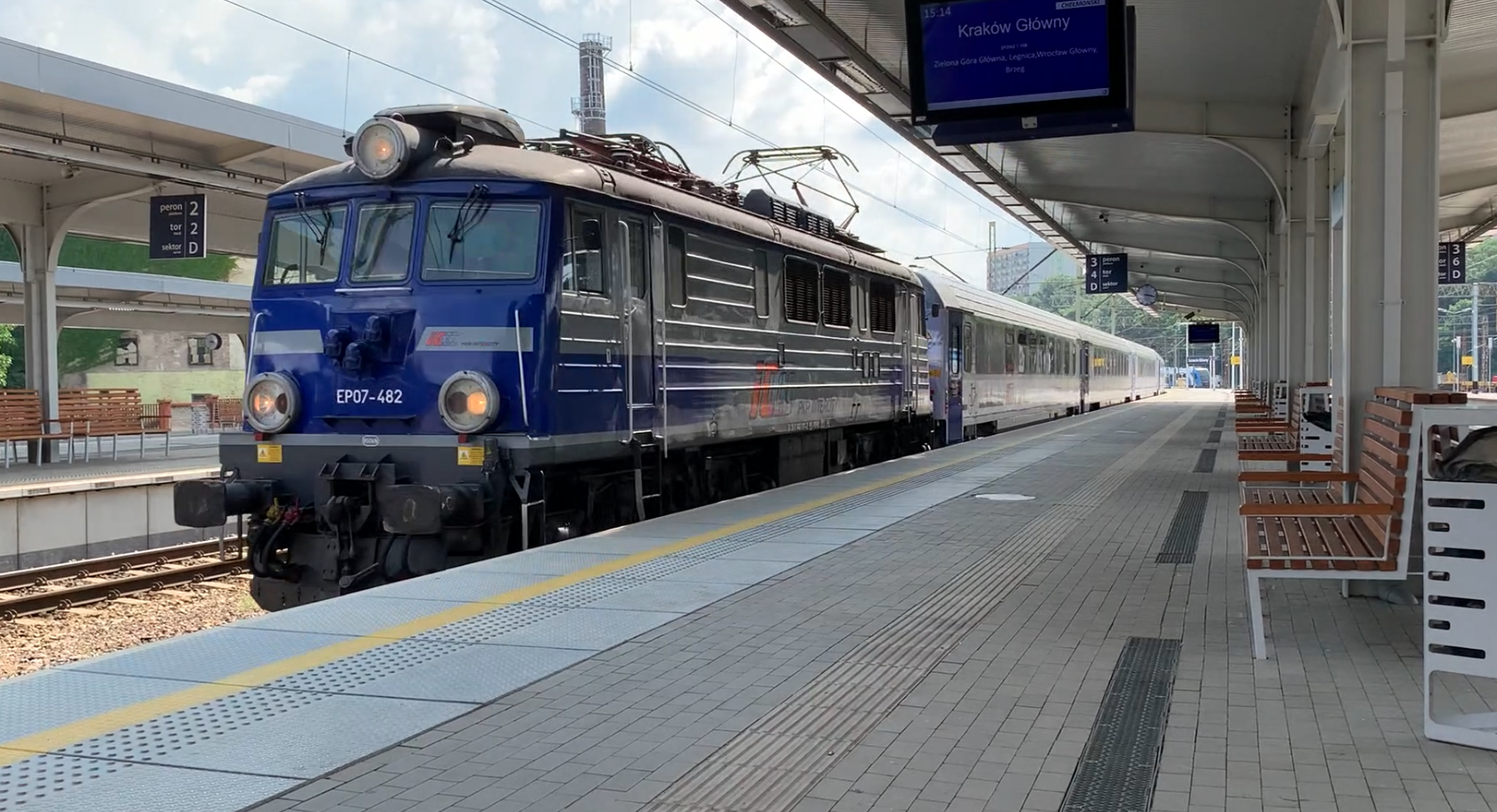
Picture description. Szczecin Main. Entry of the 8302 "Chełmoński" train to the Szczecin Główny railway station in relation to Krakow. The train has eight air-conditioned carriages. The EP07-482 locomotive is equipped with air conditioning for a mechanic.
PKP InterCity.
PKP InterCity is a Polish rail carrier that belongs to the PKP group. It deals with the transport of passengers on long routes. In Poland, it has a share of 15% in passenger transport in terms of the number of passengers, but 53% in transport measured in the passenger-kilometer scale. The company was established on August 30, 2001, with 1,500 employees. Currently (2021), it employs over 8,000 people. The company carries passengers under the Express Intercity and Express Intercity Premium brands. Under the first brand, it uses electric and diesel locomotives with classic carriages and EMUs. Under the Express Intercity Premium brand, it uses 20 EZT ED250 Pendolino trains.
Initially, the competitor was Przewozy Regionalne, which in 2008 delivered fast trains to InterCity. At that time, some of the rolling stock and employees were transferred to the InterCity company. With the introduction of the EZT ED250 Pendolino trains, the company began to make a profit. Pendolino trains are serviced at the Warszawa Grochów station.
In December 2014, after years of testing, the InterCity long-distance trains category was created. These trains were reinforced with new purchases. EZT Flirt and EZT Dart purchased, with a travel speed of 160 km / h. Electric locomotives were renovated and modernized, some of which were adapted to a traveling speed of 160 km / h. Many "Y" series cars have undergone extensive renovation and modernization. Renovations also concerned restaurant and bar cars. The company also has sleeping and berth cars. Since 2010, postal wagons are no longer used in Poland.
InterCity rolling stock.
Initially, the InterCity company did not have its own locomotives, because all of them were transferred to PKP Cargo. This turned out to be a bad solution. Therefore, the company was gradually acquiring new or modernized electric and diesel locomotives. In 2008, the company purchased 10 Eurosprinter ES64U4 Taurus multi-system electric locomotives to service international trains.
In 2009, InterCity had locomotives: 1 EP05, 157 EP07, 169 EU07, 9 EP08, 47 EP09, 50 SM42 (SP42), 19 SU45. in 2014, 10 SU160 Gama and 20 SM42-1000 Newag were purchased.
In 2020, the Olkol company refurbished 23 electric locomotives to the EU07A standard. Among other things, electric motors were replaced with asynchronous ones. The speed of the locomotives increased from 125 km / h to 160 km / h.
In 2010, InterCity had 3,131 cars. By 2015, the company modernized 218 wagons. Repairs were carried out by Polish companies: HCP (FPS - Fabryka Pojazdów Szynowych), Pesa Bydgoszcz, Newag Nowy Sącz and ZNTK "Mińsk Mazowiecki". By 2015, 54 new wagons were purchased. In the period 2016-2018, another 176 series carriages were renovated: 111A, 141A, 144A, 145A.
In 2018, InterCity ordered 81 new wagons at Fabryka Pojazdów Szynowych (HCP). In April 2018, the InterCity company ordered the overhaul of 70 carriages type 111A, 112A and 140A. In 2019, a contract was signed for the renovation of another 10 carriages type 145Ab to the standard of restaurant cars. In August 2019, another 12 EZT Flirt consisting of 8 carriages were ordered from Stadler.
Currently, in 2021, the InterCity company has electric locomotives: 1 EP05 (speed 160 km / h), 227 EU07, EP07 (speed 125 km / h), 1 EP05 (speed 160 km / h), 23 EU07A ( speed 160 km / h), 9 EP08 (speed 140 km / h), 46 EP09 (speed 160 km / h), 10 EU44 Husarz (speed 230 km / h), 30 EU160 Griffin (speed 160 km / h) h). 10 E4MSUa Newag multi-system locomotives with a maximum speed of 200 km / h were ordered for international trains.
Currently, in 2021, the InterCity company has diesel locomotives: 17 SM42 (6D) locomotives, 90 km / h, 10 SM42 (18D) locomotives, 90 km / h, 17 SM42 (6D) locomotives, 90 km / h, 10 SU42-1000 (6DI) locomotives, 90 km / h, 10 SU160 Gama (111Db) locomotives, 140 km / h. 10 SM42-2000 (6D-FPS) locomotives with a speed of 90 km / h were ordered. The best of these locomotives are the SU160 Gama, which have worthily replaced the SU45 and SU42-1000 locomotives, which are perfect for short trains.
Currently, in 2021, the InterCity company has an EMU: 20 ED250 Pendolino trains, 7 carriages, with a maximum speed of 250 km / h, 32 ED160 Flirt trains, 8 cars, with a maximum speed of 160 km / h, 20 ED161 Dart trains, 8 - wagons, with a maximum speed of 160 km / h. InterCity also has 4 ED74 Bydgostia trains in stock, 4 carriages which, for various reasons, have not entered service permanently. They are currently being rebuilt and should enter service in 2022.
Passenger service.
In 2001, the carrier launched online ticket booking. From 2005, the sale of tickets via the Internet was launched. Seating was determined by the system. Later, the possibility of choosing a place to a limited extent was introduced: by the window or by the aisle. In 2009, the carrier started selling tickets through ticket machines. In 2014, the carrier started selling tickets via mobile phones via the SkyCash mobile application. In 2015, tickets were sold in some Polish Post offices. From 2017, the online sale of tickets with one change was launched. Until now, you had to buy tickets separately. From 2021, it is possible for a passenger to select a specific seat online.
From 2014, the possibility of using mobile internet on some trains and to a limited extent was introduced. Since 2015, access to multimedia websites has been launched, including through cooperation with the Google portal.
InterCity 8302 train "Chełmoński". Train composition.
The InterCity 8302 "Chełmoński" train is one of the 266 typical trains. InterCity trains connect around 400 cities in Poland. The InterCity 8302 "Chełmoński" train connects Świnoujście - Kraków Główny. On the contrary, the InterCity 3802 "Chełmoński" Kraków Główny - Świnoujście train runs.
In the summer of 2021, the train consisted of 8 carriages, arranged in:
1 wagon 2 Combo Class 111A-30 (Bbnouvz) is a multi-purpose wagon adapted for traveling disabled people. The wagon has 68-41 seats. There is a non-compartment part in the car, 22 seats. There are two compartments in the car, mainly for parents with small children, 12 seats. There is also one wheelchair compartment with a total of 4 spaces. There is a closed system toilet for people in wheelchairs in the car. There is a changing table for children in the toilet. There is space for bicycles (6 bicycles) and skis in the vehicle. The bicycle seats have anti-theft protection. The car has 230 V sockets, USB sockets, wireless internet, passenger information system, monitoring, air conditioning. The distinguishing feature of the wagons is a painted bicycle, the inscription "Combo" and a navy blue entrance door. The door is bouncing and sliding. InterCity currently has 60 cars of this type.
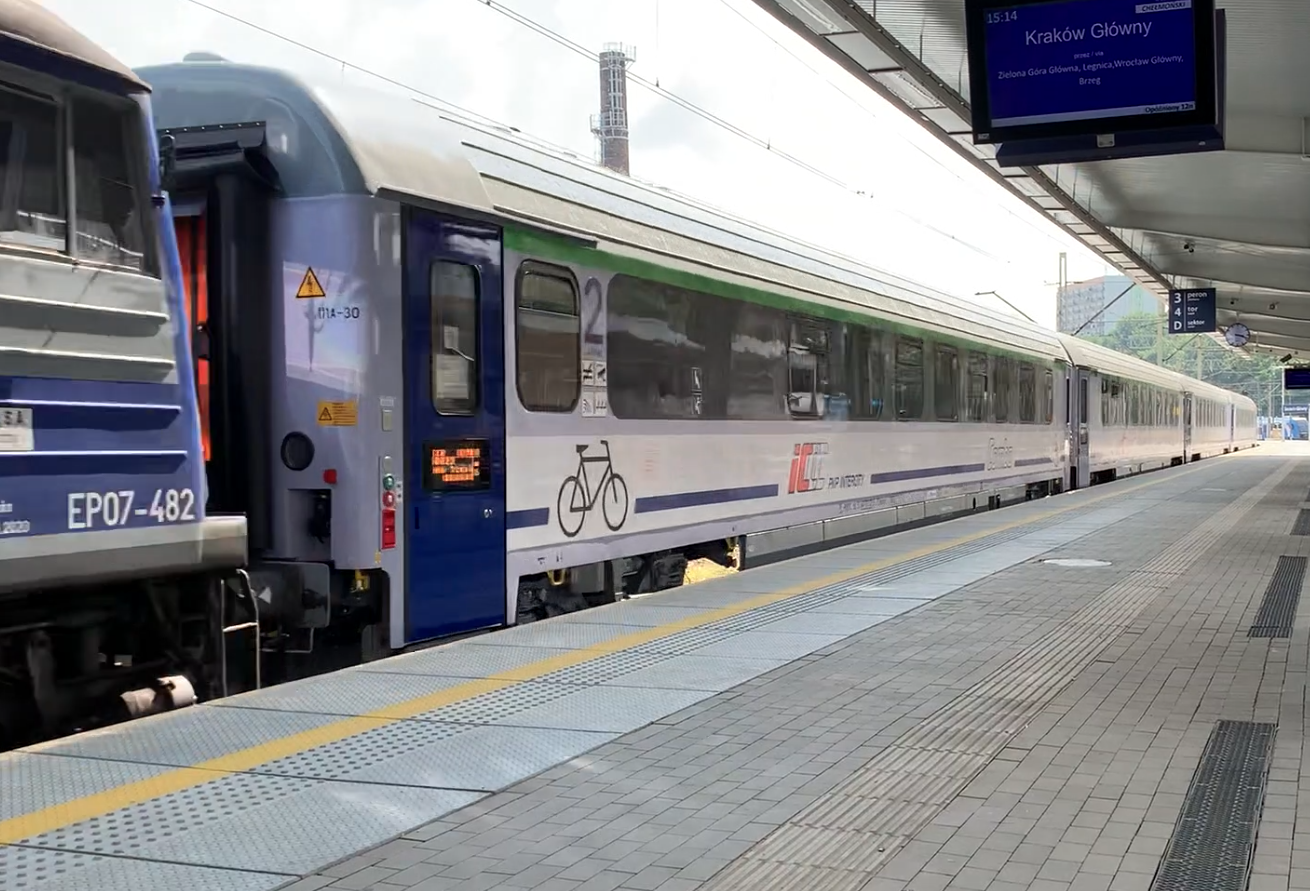
2 car 2 Class 111A-20 (Bnopuz) it is a non-compartment car. It has 72 seats. The doors are bouncing and sliding. It has two closed system toilets. The car has 230 V sockets, wireless internet, passenger information system, monitoring, air conditioning.
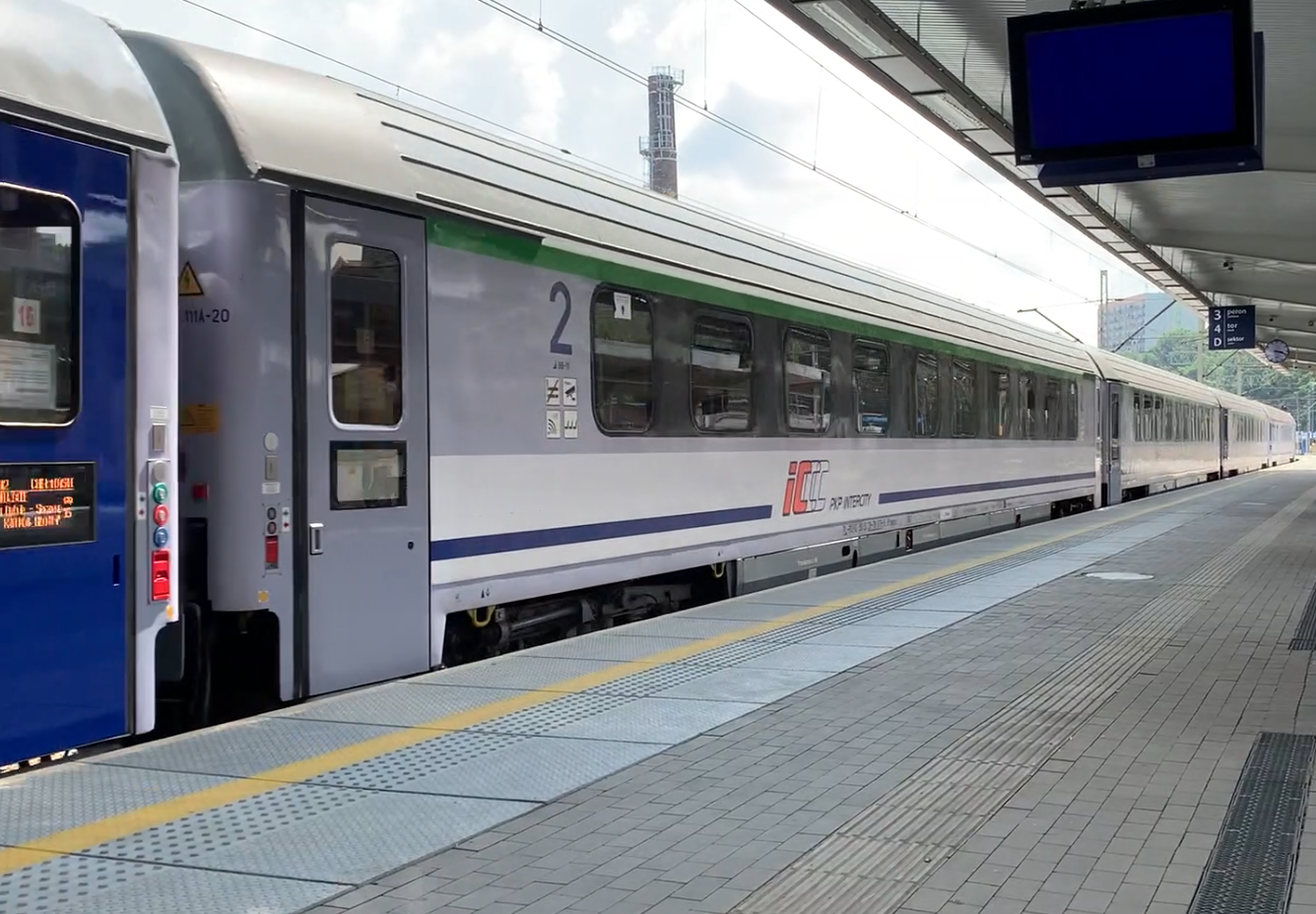
3 wagon 2 Class 111A-20 (Bnopuz).
4 wagon 1/2 Class 141A-20 (ABnouz) is a mixed car. Three compartments 1 Class and no-compartment 48 seats. The door is bounce-sliding, navy blue. The wagon has two toilets in a closed system. The car has 230 V sockets, USB sockets, wireless internet, telephone induction charging, passenger information system, monitoring, air conditioning.
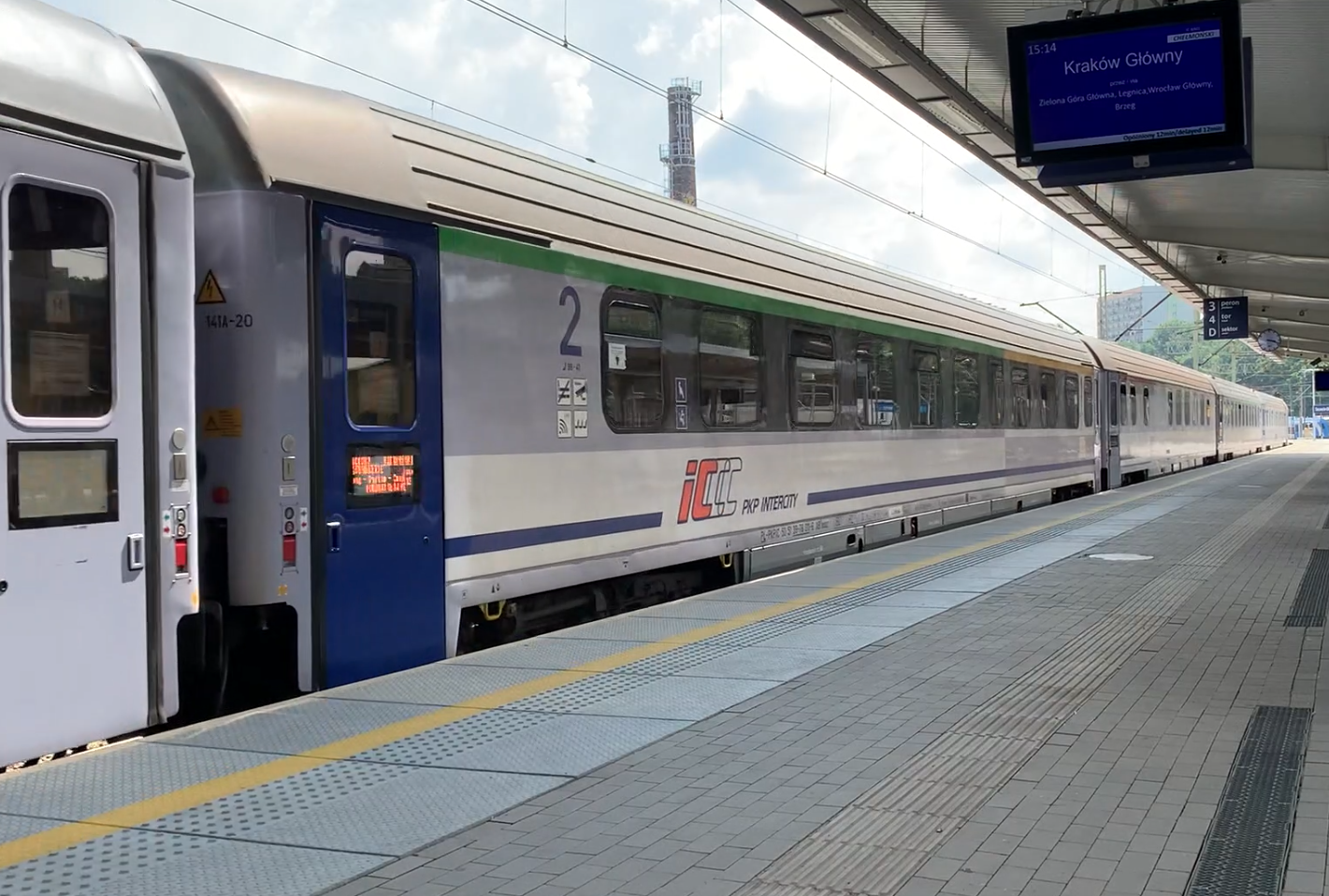
5 dining car 113Aa (WRnouz) has 16 seats and 10 bar places for consumers. The wagon has air conditioning.
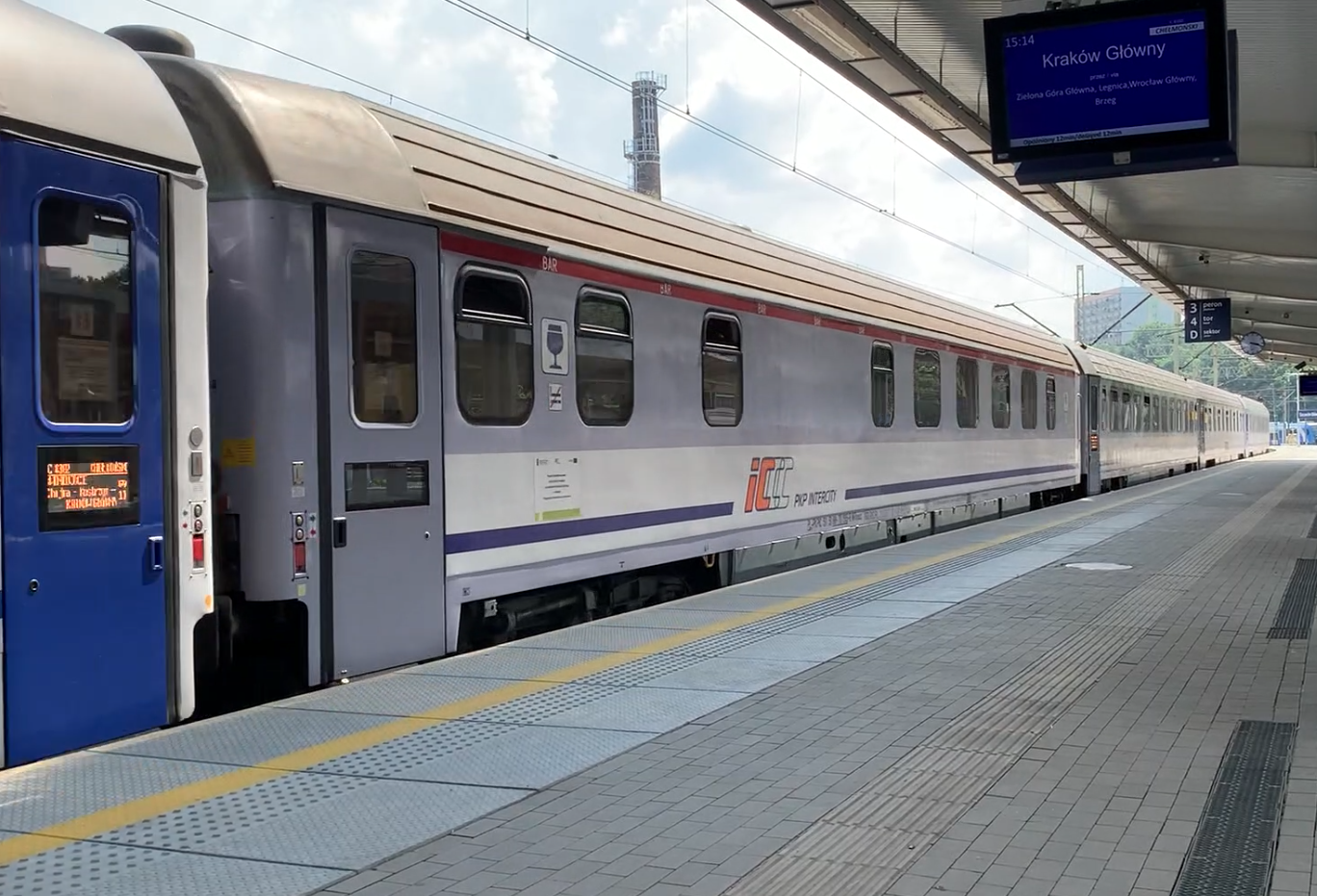
6 wagon 2 Class 174A (Bnouz) is a compartment car, 10-compartment, 6 seats each. It has two closed system toilets. The car has 230 V sockets, USB sockets, wireless internet, passenger information system, monitoring, air conditioning.
7 wagon 1 Class 140A-FPS (Cegielski) (Anouz) is a car with 9 compartments, 6 seats each. It has two closed system toilets. The car has 230 V sockets, passenger information system, monitoring, air conditioning.
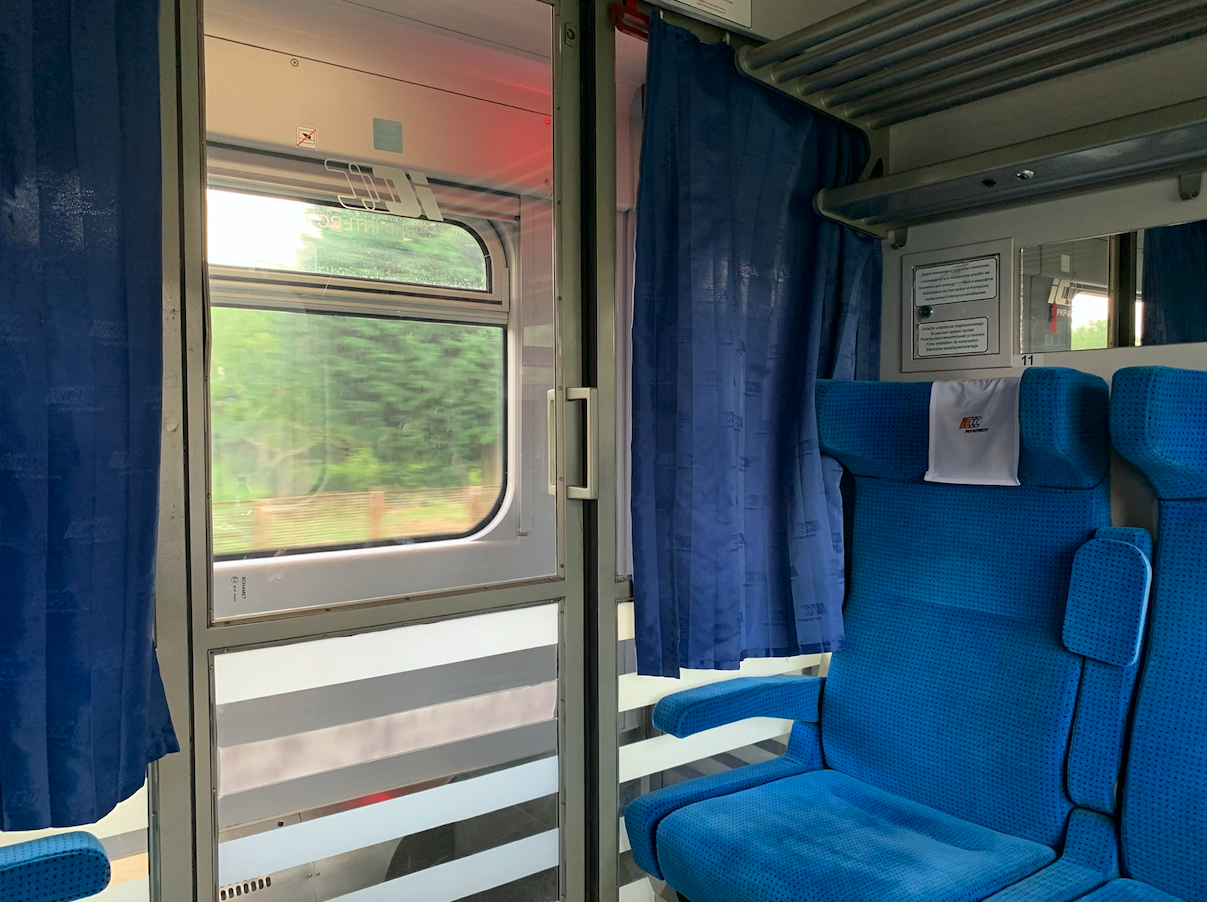
8 car of 2nd Class 141A-FPS (Cegielski) (Bnouz) is a car with 10-compartment 6 seats each. It has two closed system toilets. The car has 230 V sockets, passenger information system, monitoring, air conditioning.
All seats are blue. The gangways have automatic, pneumatic sliding doors. All external doors are automatic, rebound-sliding type with built-in light information. All toilets are closed system. Warm water for washing and blown hand dryers are available. The air-conditioning system has compressors located under the car body.
InterCity 8302 train "Chełmoński". Timetable, summer 2021.
The InterCity 8302 "Chełmoński" train set off from Świnoujście at 1.00 p.m. Subsequent stations: Międzyzdroje 13; 43, Wysoka Kamieńska 14; 05, Goleniów 14; 24, Szczecin Dąbie 14; 43, Szczecin Główny 14; 57, Gryfino 15; 30, Chojna 15; 50, Kostrzyn 16; 20, Rzepin 16; 45 , Zielona Góra Główna 17; 29, Nowa Sól 17; 45, Bytom Odrzański 17; 54, Głogów 18; 13, Lubin 18; 40, Legnica 18; 55, Wrocław Główny 19; 45, Oława 20; 27, Brzeg 20; 37 , Opole Główna 21; 02, Strzelce Opolskie 21; 26, Gliwice 21; 53, Zabrze 22; 04, Katowice 22; 19, Mysłowice 22; 33, Jaworzno Szczakowa 22.43, Trzebinia 22.54, Krzeszowice 23; 05, Kraków Main 23; 28.
The InterCity 3802 "Chełmoński" train departed from Kraków Główny at 04:58. Subsequent stations: Krzeszowice 05; 17, Trzebinia 05; 26, Jaworzno Szczakowa 05; 37, Mysłowice 05; 49, Katowice 06; 01, Zabrze 06; 25, Gliwice 06; 34, Strzelce Opolskie 07; 07, Opole Główna 07; 30 , Brzeg 07; 54, Oława 08; 03, Wrocław Główny 08; 22, Legnica 09; 28, Lubin 09; 42, Głogów 10; 09, Bytom Odrzański 10; 28, Nowa Sól 10; 37, Zielona Góra Główna 10; 52 , Rzepin 11; 38, Kostrzyn 12; 02, Chojna 12; 35, Gryfino 12; 56, Szczecin Główny 13; 14, Szczecin Dąbie 13; 30, Goleniów 13; 47, Wysoka Kamieńska 14; 06, Międzyzdroje 14; 33, Świnoujście 14; 54.
The length of the route is 753 km. Locomotives were replaced at the Wrocław Główny station. The EP09 locomotive ran the train on the section Wrocław Główny - Kraków Główny. On the section Wrocław Główny - Świnoujście there is an EP07 locomotive. Therefore, the stop at the Wrocław Główny station lasted 20 minutes. There were two trains which, according to the schedule, crossed at the Wysoka Kamieńska station. To get there, trains often had a delay of 20-30 minutes. The delays were mainly due to renovation works that were carried out at the stations in western Poland at that time. Some stations in western Poland have short platforms and the eight-car train cannot accommodate them. Therefore, in front of these stations, the conductor team asked for the disembarking passengers to pass to the sixth car in the sequence. The platforms are approximately 170 m long, with a total length of 215 m. In the autumn period of 2021, the InterCity 8302/3802 "Chełmoński" train consisted of seven carriages.
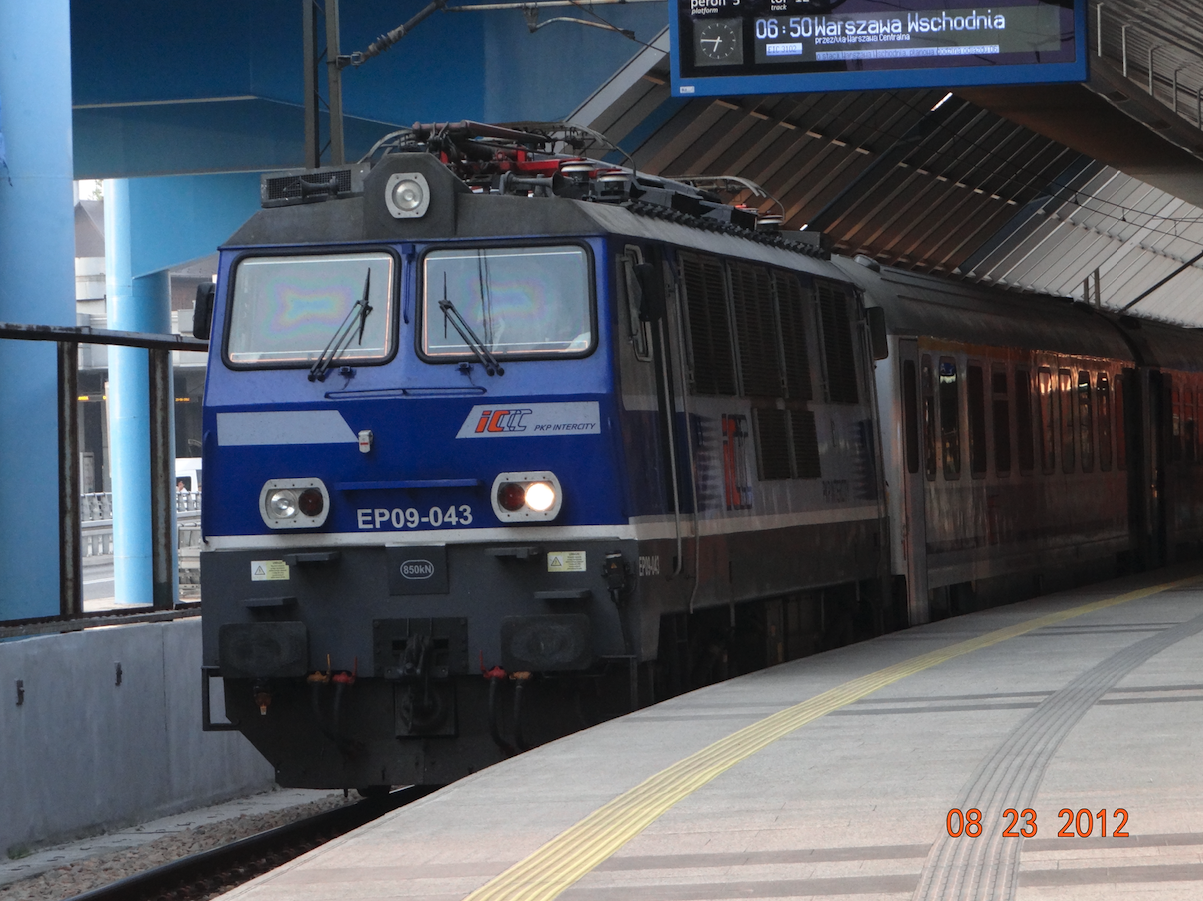
Trains are always kept clean. The conductor teams are always impeccably dressed in uniforms, cultured and willing to help passengers. They can help passengers who may miss the next train due to a delay. The latter train can only depart after the arrival of the first one. This generates some delays, but it is probably more important that everyone reaches their destination without staying overnight at the station.
In the 1970s, the Kraków Główny - Świnoujście trains usually ran on a different route. From Wrocław Główny through: Leszno, Poznań Główny, Krzyż, Choszczno, Stargard, Szczecin Dąbie. There were two alternative routes in Lower Silesia: through Strzelce Opolskie or through Kędzierzyn Koźle.
The name "Chełmoński" was previously used by the InterCity 6304 Jelenia Góra - Przemyśl, 3604 Przemyśl - Jelenia Góra train. Its route was as follows: Jelenia Góra, Wałbrzych Główny, Wałbrzych Miasto, Wrocław Główny, Oława, Brzeg, Opole Główna, Lubliniec - Częstochowa Stradom, Kraków Główny, Kraków Płaszów, Bochnia, Tarnów, Dębica, Rzeszów Główny, Łańcut, Przeworsk, Jarosław, Przemyśl Główny.
Written by Karol Placha Hetman
